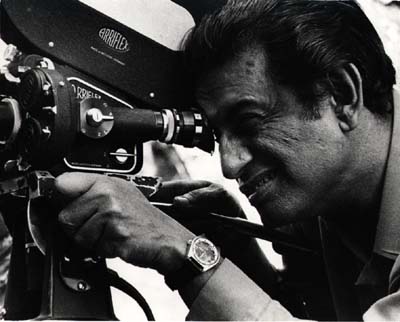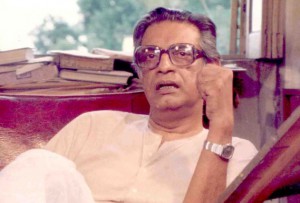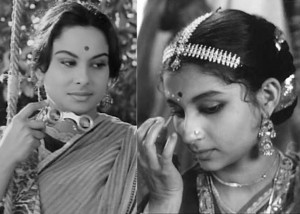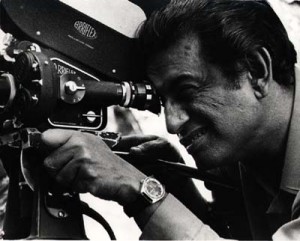
Satyajit Ray
More than just movies, Satyajit Ray gave humanity a different face altogether through the wonders of Indian cinema, which still have a resounding effect on what Indian culture, ideas and traditions all stand for. More than just a director, he was a visionary of what movies truly meant for Indians and he was perhaps one of the few Indian filmmakers who took the Indian cinematic experience to a level beyond what was understood, and broke the popular notions and thought processes that made him and his movies extraordinary, and truly one of a kind.

Satyajit Ray
With all that being said, the one fact that we cannot overlook is the portrayal of women in Satyajit Ray’s movies. His movies went several steps beyond the norms of how women were defined in Indian cinema. The sea of strength and courage that was exhibited through the various shades of female characters puts Indian cinema on a platform which is elevated and refined, and what may be considered as cinematic pride for India.
Origin and History
Satyajit Ray was born in the buzzing city of Calcutta on May 2nd 1921. He came from a family which was greatly inclined towards Literature and cinematic Arts which instilled in him the seeds of filmmaking from an early age. He directed 36 films which have all been different, yet have always depicted the same essence in thoughts when it came to Indian women.
The women in his movies always played the roles of strong protagonists who were shown as more courageous and bold when compared to the male characters, something that was completely different than how Indian actresses were seen in those days. The meek and demure were exchanged for the bold and the beautiful in a subtle yet endearing way.
Being a true Bengali at heart, Satyajit Ray delved deep into the Bengali culture and that showed in the female characters on screen. Popular Bollywood actresses like Sharmila Tagore and Simi Grewal have been depicted in true Bengali attire and tradition as well, which added to the realm of his various stories and cinematic narratives.
Style
When one sees the women in Satyajit Ray’s movies, then a certain style can be noticed, and that is the trend of simplicity. The traditional red Bindi on the forehead, simple long hair tied in a bun or left loose, and a pure Cotton sari which illuminated the innocence and unspoken strength of his characters were the main highlights that seemed like a breath of fresh air in Indian cinema, especially when compared to the glossy, typical female actresses that represented a stereotypical image.
The one apparent style of clothing rampant in all his movies consisted of simple and sober handloom Cotton saris. The saris were never over the top in style and always had a simple gold border at the most. The colors were never too bright and mostly consisted of shades like yellow, white, or red with white which were the typical shades inherent in a Bengali Cotton sari.
The raw ease with which these actresses fluttered across the screen made one pay more attention to their personality or their aura rather than to their makeup or hair, which was always minimal or none. The actresses in all his movies were kept traditional in their appeal while their mannerisms were in contrast to their attire. The simple gold chain around the neck or the pallu that covered their head at all times, or the slightly smudged kohl eyeliner were always a part and parcel of what defined his actresses, and their innovative style quotient.
Global Appeal
What Satyajit Ray actually showcased was Indian feminism through what was real and tangible. What was even more remarkable was how his actresses in spite of wearing simple Cotton saris or no makeup had a sensual appeal that made them far more interesting and attractive even when compared to the yester year’s actresses who always went for heavy makeup or exotic sari styles. Rustic and rooted was the typical appearance of all his actresses, which still serves as inspiration for many young and established directors, not only in India but the world over. Sharmila Tagore who considered him her mentor and guide said “his films are “contemporary” and relevant even today across the world.
When people across the world think of Indian women, then the image portrayed by Satyajit Ray does complete justice to that. Simple, refined, subtle, yet strong were beautifully presented through the glamour-free style of his female characters, who were deeply rooted in Indian tradition and cultural splendor.
Interesting Facts and Comparisons
- Satyajit Ray was an ardent fan of English movies, but he always stayed true to his cultural Indian roots and that was exemplified through his movies
- He was and is still referred to as ‘Father of Indian cinema’
- Some of his famous movies were Aparajito, Charulata, Pather Panchali and World of Apu
- Satyajit Ray received an Oscar just 24 days before his death in 1992.
- He died at the age of 70
- He wrote most of his scripts in Bengali
References
Categories: Bollywood & Beyond, Indian Cinema


